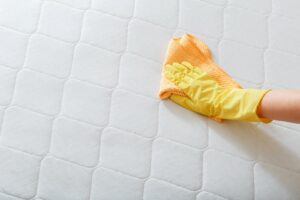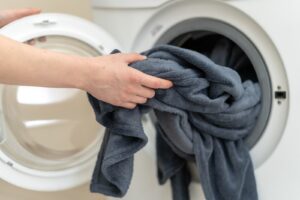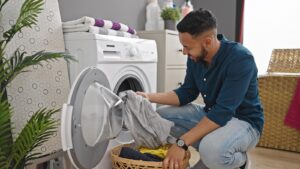How to Fluff a Pillow
Your pillow is an essential part of your sleep environment that you use just as much as your mattress. The ideal pillow provides neck support and promotes healthy spinal alignment while cushioning your head. However, pillows typically flatten over time, requiring regular fluffing.
Fluffing your pillow helps restore its loft by aerating and redistributing the fill, ensuring there aren’t any uncomfortable lumps. Depending on the fill material, fluffing your pillow may be an important part of your daily routine.
To help you fluff your pillow more effectively, we’ll discuss several reasons why pillows go flat and break down the step-by-step process for fluffing by hand, in the dryer, and outside. We’ll also share extra tips for the best results. Finally, we’ll describe common signs that it’s time to replace your pillow.
Find a Pillow That’s Right for You
Looking for a new pillow? Take the quiz below to find the perfect pillow for your needs.
Trouble sleeping?
Answer these 5 easy questions to discover your perfect pillow

Trouble sleeping?
Answer these 5 easy questions to discover your perfect pillow
What position do you sleep in?

Side

Back

Stomach
Why Pillows Go Flat
Pillows go flat for several reasons, including the weight of your head, moisture, and the accumulation of dirt and dead skin cells. Over time, the pillow fill compresses beneath your head, especially if you sleep in the same position and only use one area of the surface. Pillows also easily absorb moisture, which flattens the fill and reduces the loft. Additionally, pillows tend to collect skin cells, natural oils, and dust, weighing down the fill and making an attractive haven for dust mites.
Some types of pillow fill flatten more quickly than others. Down and down alternative compress easily beneath weight, often requiring daily fluffing. Despite being less prone to clumping, shredded memory foam and shredded latex may also need regular fluffing to enhance their loft. Solid foam, solid latex, and buckwheat pillows do not require conventional fluffing, though they may still need the occasional freshening up.
Every Way to Fluff a Pillow
Fluffing a pillow is a simple task, but there are many ways to do it. Manual fluffing is the most common method, but you can also use your dryer or fresh air depending on the type of pillow and how flat it is.
How to Fluff a Pillow by Hand
Fluffing by hand is quick and easy whether your pillow contains shredded memory foam, shredded latex, down, or down alternative. Hold the pillow’s opposite ends and work them in and out as if you’re playing an accordion. This breaks up clumps of fill and forces air into the pillow to restore its loft. Repeat this process on both the long and short sides of the pillow.
If your pillow is especially lumpy, press your hands deep into it with a massaging motion. Work your way across the entire surface until the fill is evenly dispersed.
How to Fluff a Pillow in the Dryer
You can fluff some pillows in a dryer, but not all pillows are dryer-safe. Check the label for care instructions. Even if your pillow is dryer-safe, some fill materials require a low heat setting and regular monitoring to avoid damage.
When fluffing your pillow in the dryer, include some type of agitator to knead it and break up any lumps inside. A tennis ball in a tube sock works well, as does knotted clean clothing or towels.
How to Fluff a Pillow With Some Fresh Air
Placing your pillow outside in the sun helps remove any moisture that may otherwise flatten it. However, the weather needs to be warm and dry to prevent additional moisture from seeping into the pillow.
Remove any protective barrier, like the pillowcase, and place the pillow in a clean, dry, sunny spot. The sunshine’s warmth and heat help remove foul odors and kill bacteria. You can also hang the pillow on a clothesline. This allows fresh air to flow into the pillow and fluff the fill. Leave the pillow outside for several hours so the fill has time to dry and expand.
Other Tips and Tricks to Fluff a Pillow
Fluffing plays a vital role in preserving the loft of your pillow, which contributes to healthy posture and overall comfort. It ensures even fill distribution and maximizes the pillow’s longevity. Here, we share a few more tips to help keep your pillow in optimal shape.
- If you have an adjustable pillow, you can add more fill to restore its loft and plushness. Adjustable pillows typically feature a zippered cover for easy access. They may come with extra fill, or you may be able to purchase more fill from the manufacturer.
- Try using a pillow protector beneath a traditional pillowcase to prevent the pillow from absorbing moisture, oils, and debris. Sweat, dead skin, hair oil, and personal care products can significantly weigh down fill.
- If washing your pillow made it flat, manually break up any clumps and let it dry thoroughly. You might leave it in a warm, sunny area for several hours or use the dryer fluffing method.
- Don’t leave your pillow in a moist or dark place during the day. If you sweat at night and keep your bedroom dark all day, the moisture in your pillow may linger, creating a potential breeding ground for bacteria. Opening your window blinds exposes your pillow to sunshine, which helps the moisture evaporate.
When It’s Time to Replace Your Pillow
Sometimes, all fluffing attempts fail, and your flat pillow can’t be revived. If so, it’s probably time to replace your pillow. Depending on the type of fill, you’ll probably need a new pillow every one to two years.
Inexpensive models with polyester fill tend to last about one year, while high-quality latex pillows often hold up for five years or more. Most memory foam pillows and down pillows have expected life spans of two to three years. Investing in a high-quality pillow often means you won’t have to replace it as often.
Watch for telltale signs that you need a new pillow. Odors, lumpy fill, stains, and lack of support may be your first clues. You may also experience more allergy symptoms due to the buildup of dead skin cells, dust mites, and bacteria. Additionally, inadequate support can result in misalignment of the spine. If you adjust your pillow throughout the night or frequently wake up with neck pain, your current pillow may no longer be the best pillow for you.

Still have questions? Ask our community!
Join our Sleep Care Community — a trusted hub of sleep health professionals, product specialists, and people just like you. Whether you need expert sleep advice for your insomnia or you’re searching for the perfect mattress, we’ve got you covered. Get personalized guidance from the experts who know sleep best.























